If You Dont Feed the Dog at Home Its Going to Get in the Neighborhood Trash
State law bans food scraps from the trash.
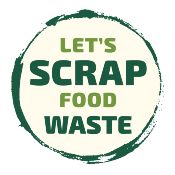 See our Food Scrap Ban Guidance with requirements for residents, businesses, and haulers.
See our Food Scrap Ban Guidance with requirements for residents, businesses, and haulers.
Check out Compost with Confidence for a quick (printable) summary.
Print a handyfood scrap guide for your fridge.
See tips for reducing food waste at scrapfoodwaste.org.
Find a Food Scrap Hauler.
Read the Dirt on Compost for info on backyard composting.
Learn about requirements and options for Rental Properties.
Still have questions? Check out ourFood Scrap Management FAQ.
Food scraps are:
-
 Parts of food items that are typically discarded rather than eaten: peels, rinds, cores, eggshells, seeds, pits, bones, coffee grounds and paper filters, loose-leaf tea & paper tea bags, and fats/oils/grease.
Parts of food items that are typically discarded rather than eaten: peels, rinds, cores, eggshells, seeds, pits, bones, coffee grounds and paper filters, loose-leaf tea & paper tea bags, and fats/oils/grease. - Food that was not finished: "plate scraps" or leftovers that went bad. Any type of food can become scraps--bread, pasta, soup, veggies, fruit, sauces, meat, dairy, sweets, etc.
These items can go in your food scrap collection container. You may be able to put other items in with your food scraps depending where your scraps end up. Read on to learn more.
What do I have to do?
If it was once part of something alive, like a plant or animal, it does not belong in the landfill.Food scraps and yard debris (leaves, grass, brush clippings, etc.) will need to be managed separately from trash.
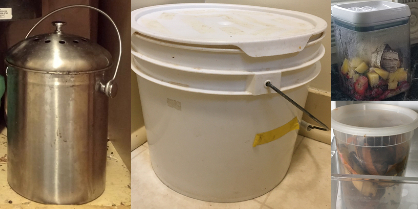 The first step is to collect your food scraps in a container. There's no right way to do this. You can reuse a large yogurt tub or bucket, buy a food scrap container, or keep a plastic bag in the freezer--find a method that works for you based on how much food scraps you generate, how often you want to empty and wash your container, etc. You'll empty your container regularly into a backyard bin if you compost in your yard, you hauler will empty your food scrap tote or bucket if you subscribe to a pick-up, or you'll dump your scraps into a food scrap cart at a drop-off.
The first step is to collect your food scraps in a container. There's no right way to do this. You can reuse a large yogurt tub or bucket, buy a food scrap container, or keep a plastic bag in the freezer--find a method that works for you based on how much food scraps you generate, how often you want to empty and wash your container, etc. You'll empty your container regularly into a backyard bin if you compost in your yard, you hauler will empty your food scrap tote or bucket if you subscribe to a pick-up, or you'll dump your scraps into a food scrap cart at a drop-off.
Kitchen Tips:
-
 Unless you empty your kitchen container every day or two, use a container with a lid.
Unless you empty your kitchen container every day or two, use a container with a lid. - Wash or rinse your container regularly or each time you empty it.
- To store your food scraps for a while between trips to a drop-off or your pick-up:
- Keep them in a bag or container in your freezer (bread bags work well).
- Try the bokashi process, which ferments the food scraps so they don't smell.
- If you don't mind emptying and cleaning a messier bin, you can simply store scraps in a larger container with a tight lid (like a 5-gallon bucket) in an out-of-the-way place, like an entryway or garage. To contain odors, you can cover the food scraps with a thin layer of dried, brown leaves or wood shavings each time you empty your kitchen container into the larger container.
- Learn more tips in the Food Scrap Management FAQ for Residents.
Why separate food scraps from the trash?
Food scraps and yard debris make up ~30% of a typical Vermont family's waste; at restaurants and cafeterias, food scraps can be over half the waste. K eeping these materials out of the landfill has a big impact:
- When it is trapped in a landfill, food waste decomposes slowly, and without oxygen. This process produces methane, which is a greenhouse gas 84 times more powerful thanCO2 over a 20-year period.
- Food scraps contain valuable nutrients that are good for the soil . Finished compost can be used in gardens, farms, and landscaping.
- Generating less trash conserves landfill space.
- Composting puts your waste to work supporting composters, local farmers, and food scrap haulers.
- Without food scraps in it, garbage is cleaner and less smelly.
How does food waste relate to climate change?
According to the book Drawdown, food that is produced but not eaten contributes 8% of the world's total greenhouse gas emissions, and reducing food waste is one of the single most impactful actions for reducing the effects of climate change. Composting food scraps is also an important climate solution.
How can I waste less food?
Buy only what you need and eat what you buy.
Learn more at scrapfoodwaste.org.
External resources:
- Save the Food
- Love food Hate Waste
- ReFED
What can I do with my food scraps?
See how real people across Vermont manage their food scraps in the Scrapbook at scrapfoodwaste.org.
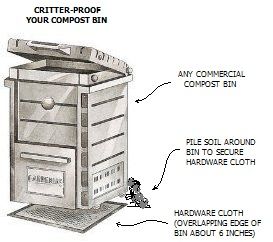 A. Compost in your yard
A. Compost in your yard
Make your own bin or purchase a container (some solid waste districts or towns offer free workshops and discounted bins). Your bin should be enclosed and sit on top of wire-mesh hardware cloth, so animals, including dogs, can't get in.
Cover every bucket of food scraps ("greens") with three buckets of dried yard debris ("browns"), like leaves, dry grass, sawdust, or chipped wood. Covering food scraps with browns reduces odors and creates a good carbon to nitrogen ratio for soil bacteria and other decomposers to break down the pile.
Once the material has decomposed for months (speed up the process by mixing it once in a while) and cured for a few more months, you can use it as a nutrient boost for your garden. Mature compost looks and smells like dark brown soil.
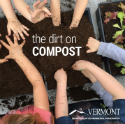 If you compost in a backyard, the law allows you to throw meat, bones, and grease in the trash (including from seafood). These items don't break down quickly in small-scale compost systems.
If you compost in a backyard, the law allows you to throw meat, bones, and grease in the trash (including from seafood). These items don't break down quickly in small-scale compost systems.
To get started with on-site composting,readThe Dirt on Compost, take theVermont Master Composter Course, attend acomposting workshop, or explore the other resources at the bottom of this page.
What about bears and other animals?
- Animals can smell meat and bones, so don't compost them in your backyard bin. Cover food scraps completely with dry, brown plant material to contain any smells.
- Take down birdfeeders, except when bears are hibernating. Bird seed draws bears into yards. Learn more about backyard composting in bear country from the Vermont Fish & Wildlife Department.
- Keep dogs out of the compost bin. They can get very sick if they eat decomposing food scraps.
Are there other options?
Some people manage food scraps at home, indoors, using worm bins or food scrap machines.
B. Digest in your yard
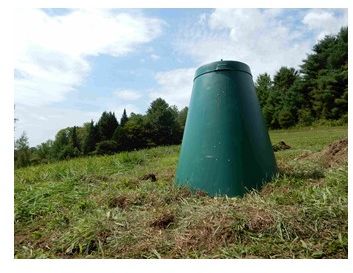 Solar digesters use the sun's energy to break down food scraps.
Solar digesters use the sun's energy to break down food scraps.
You don't need to add browns, and it IS ok to include meat, bones, and other animal products.
Similar to backyard composting, the law allows you to throw meat, bones, and their fats (including seafood) in the trash if you want.
Solar Digesters decompose waste material almost completely, so you will not end up with finished compost that you can use in your garden.
You may be able to purchase a solar digester from your waste district or town.
C. Feed animals
If you have chickens or pigs, you can feed household scraps to them.
To prevent the spread of diseases, the Agency of Agriculture prohibits feeding pigs food scraps that have touched meat or fish, including their organs, bones, and juices. These regulations do not apply to feeding personal food scraps to pigs that are for personal consumption. To learn more, consult Feeding Food Scraps to Pigs and the Agency of Agriculture's Guidance on Feeding Food Scraps to Pigs.
The Agency does allow feeding food scraps to chickens, at a small scale.
Some food scraps from food manufacturing, such as spent brewery grain and whey, can also be fed to animals.
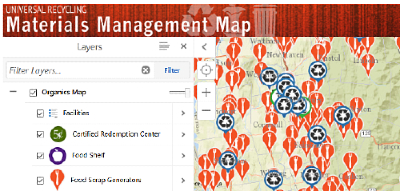
D. Send it to "The Pros"
Remember! Ask your drop-off facility or hauler what materials they accept. 
- Drop-off composting: You can drop off food scraps and yard debris at any transfer station or bag-drop in Vermont. Many compost facilities also have drop-offs. Consult your local Waste Management District or town or our Materials Management Map to learn about services in your area.
- Curbside pick-up: Ask your hauler if they offer food scrap pick-up, or find a hauler on the statewide list of food scrap haulers. In Vermont, hauling food scraps for a fee requires a state hauler permit. If you live in bear country, check out these tips for keeping bears away from food scrap containers. Many of these tips will help keep bears away from garbage too.
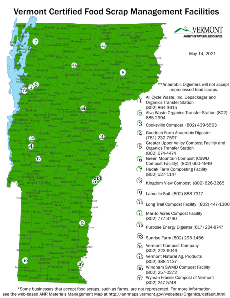
What happens to the food scraps I've separated?
Most of Vermont's food scraps are composted at composting facilities and some are fed to animals or processed at anaerobic digesters. Click on the map to view facilities around the state.
What if I still have questions?
Check out our Frequently Asked Questions handouts for residents, businesses & institutions, landlords, condo associations, and resorts, hotels, and other lodging establishments, or explore the resources at the bottom of this page. You can also contact your local solid waste district or town or VT DEC (at 802-828-1138; ANR.ScrapFoodWaste@vermont.gov) with questions or for no-cost assistance.
Vermont Compost Operator Training
If you are interested in operating a certified compost facility in Vermont or you want to increase your larger-than-backyard-scale composting knowledge, sign up for the one-day Vermont Compost Operator Course (~$30 course fee). To put your name on the contact list for the next training, go to Compost Technical Services' website. For backyard composting training, contact your local waste district or town or sign up for the Vermont Master Composter Course.
Source: https://dec.vermont.gov/waste-management/solid/materials-mgmt/organic-materials


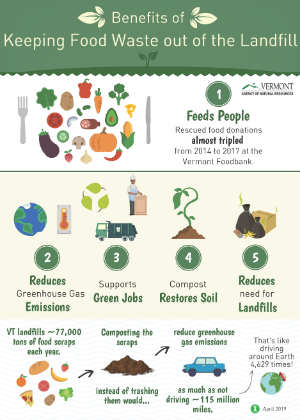

0 Response to "If You Dont Feed the Dog at Home Its Going to Get in the Neighborhood Trash"
Post a Comment